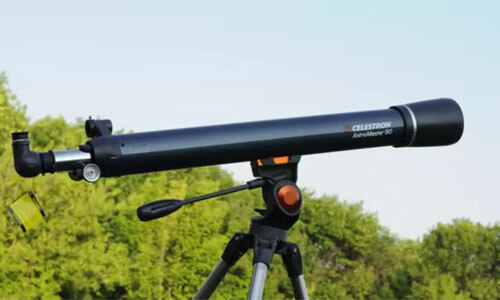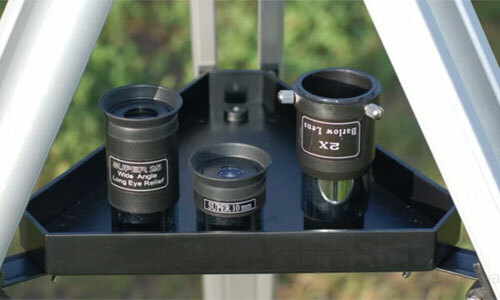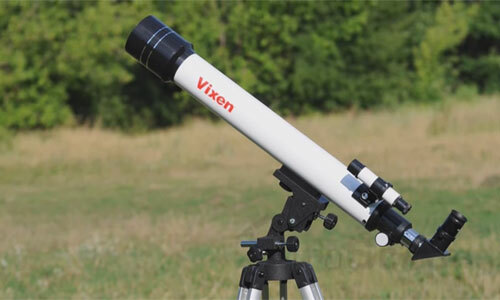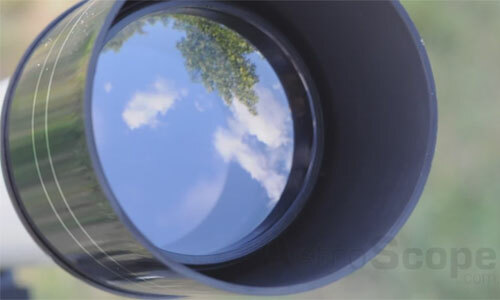As well as many millennia ago, the starry sky beckons people with its amazing beauty and a lot of incomprehensible mysteries, excites fantasy, making us dream of distant planets, stars and galaxies. It is unlikely that there will be an indifferent person to this theme, the mysteries of the cosmic abyss always aroused a keen interest.

To become a little closer to the wonderful world of stars the telescope will help - an ancient optical device invented by Galileo. Today, a wide variety of telescope models can be found on sale, but it's not always easy to decide with a starter who is new to all the subtleties of these devices. Those who do not know how to choose a telescope will be helped by our step-by-step instruction.
Step 1: choose the optical system
In the modern amateur telescope, one of five optical systems can be used. Each of them should be discussed in detail.
Refractory Optical System
In lenses of telescopes with such an optical system, a lens is used. As a rule, these devices are longer than any other species. This system includes refractors-apochromats, which can be used for astrophotography.
Observe the starry sky with the help of a refractive telescope is most convenient in an open area. For the house( observation from a balcony or from an open window) it is poorly adapted. Due to the ease of operation, and also the unpretentiousness to temperature changes, a telescope with such an optical system is suitable for a child.
The lack of refractory systems is due to the ability of the lens to decompose a beam of light into spectral components. This leads to the appearance of image defects, which become more noticeable, the larger the magnification of the telescope. Therefore, powerful telescopes are equipped with a reflex optical system, which will be discussed below.
Reflective optical system
The lens of the telescope with a reflex optic system is a concave mirror with a parabolic profile installed at the rear of the device. Mirror lens has two significant advantages:
- First, it is easier to manufacture than a lens, due to what reflex telescopes cost an order of magnitude cheaper than refractive telescopes;
- Secondly, the mirror does not spread a beam of light into its components, so the reflector telescope displays objects without defects typical of refractor telescopes.
At the same time, the mirror lens is more fastidious to the influence of external conditions. In particular, sharp temperature changes are dangerous. After completion of observations, the device is recommended to be hidden in a cover.
In amateur reflectors, mirrors with a diameter of 80 to 250 mm are installed. In general, the reflector is a good telescope for those who want to observe distant objects that emit a dim light, but are not willing to pay a sky-high sum.
Optical systems Cassegrain, Maksutov-Cassegrain, Schmidt-Cassegrain
As already mentioned, refractor lenses somewhat distort the image due to the spectral decomposition of the light beam. This phenomenon is called "chromatic aberration".But mirror telescopes( reflectors) are not without flaws. They exhibit such negative effects as spherical aberration and coma.
In order to eliminate the above-mentioned defects, types of telescopes were developed, optical systems which, in addition to mirrors, are equipped with image correcting lenses and plates. Such devices give a close to an ideal image, have small dimensions and are characterized by good transportability.
Step 2: choose mount
To observe the starry sky, holding a telescope in your hands, is almost impossible. The slight trembling of the hands is amplified, accordingly the magnifying power of the device and the observed object jumps in the eyepiece, like an unbroken stallion. Therefore, during operation the telescope is placed on a special mobile support, which is called "mount".

To date, a huge number of different designs of mountings have been developed, but in amateur instruments, mainly one of three varieties is used:
- azimuth;
- equatorial;
- system of Dobson.
It is better for a beginner to choose a telescope with azimuth mount. It is quite simple and understandable, even a child can easily handle it. The best azimuth mount is suitable for working with refractor-type telescopes.
Mounting the equatorial type allows you to define objects by coordinates. For this, it is sufficient to adjust it to the latitude of the terrain in which the observer is located. If you want to search for comets and observe objects of low brightness, the location of which is difficult to determine visually, then equatorial mounting suits you best. It is preferred by those who are engaged in astrophotography. Most often the equatorial type is used for reflex telescopes.
The Dobson system is a compromise. With its help it is difficult to find weak objects, but it is reliable, simple, and most importantly - it is quite cheap. As a rule, it is equipped with powerful reflectors to compensate for the high cost of the telescope itself.
Step 3: Additional elements of
When choosing a telescope, ask the seller what accessories can be purchased in addition to make observations more interesting. In most cases, the following are proposed:
- eyepieces;
- Barlow lenses( allow to significantly enlarge the image of the object);
- filters( some objects are better viewed in a certain spectral range);
- electric motors( turn the telescope, compensating for the rotation of the Earth);
- prism.

Step 4: Maximize the
With the help of additional eyepieces and lenses, you can significantly increase the magnification( magnification) of your telescope, but there is a limit to everything. The maximum permissible multiplicity is easy to determine. To do this, the value of the diameter of the lens, taken in millimeters( aperture), must be multiplied by a factor of 1.4.An increase in the multiplicity beyond the calculated limit will lead to the formation of image defects, the degree of which depends on the particular model of the telescope.

There is also an absolute limit of magnification, which is determined by multiplying the aperture by a factor of 2. This is the physical limit, with a further increase the image of the object will darken and become more blurred, so the detail will only get worse. If such a multiplicity for your problems is not enough, it is better to buy a telescope with a large diameter lens.
Step 5: define the range of tasks for
If your path to astronomical discoveries is just beginning, you can buy a refractor with a diameter of 70-90 mm, a reflector with a mirror 110-130 mm, or a 90-110 mm Maksutov-Cassegrain system.
As a gift, the child can be presented with an inexpensive refractor or reflector with a lens diameter of 70-80 mm. Such models are more resistant to inaccurate treatment, often manifested by children, and their capacity for the first star excursions is quite enough.

For more serious studies, for example, the study of planets, a refractor with a lens diameter of 120-150 mm is suitable. Due to the lack of shielding, these tools give a bright and contrasting image.
Well, those who want to plunge into the world of distant galaxies and mysterious nebulae will have to shell out a telescope of a reflex type with a mirror diameter of 200-250 mm, with an equatorial mount in the kit.
If you are going to often carry a telescope, getting to the place of observation, then it is worth opting for the Maksutov-Cassegrain optical system. Any type of transportation these light and compact devices carry the best.
Separately it is necessary to say about astrophotography. Photographing space objects requires a long exposure, during which our planet manages to turn a few degrees. Therefore, the mounting of your telescope must be equipped with an electric drive, which will hold the device in the direction of the subject being photographed.
Step 6: Popular Models
The best way to protect yourself from buying a substandard product is to trust one of the well-known, trusted buyers, brands.
For beginner astronomers, we can recommend:
- Sky-Watcher BK 707AZ2;
- Meade NG70-SM;
- Celestron AstroMaster 70EQ;
- Vixen Space Eye 70m.
Their cost varies from 4 to 7 thousand rubles.
For 15-20 thousand rubles. You can buy models with the homing function. Such a device has a built-in database of objects and on any of them is induced automatically by a command from the console.
We wish you pleasant observations and amazing astronomical discoveries!
